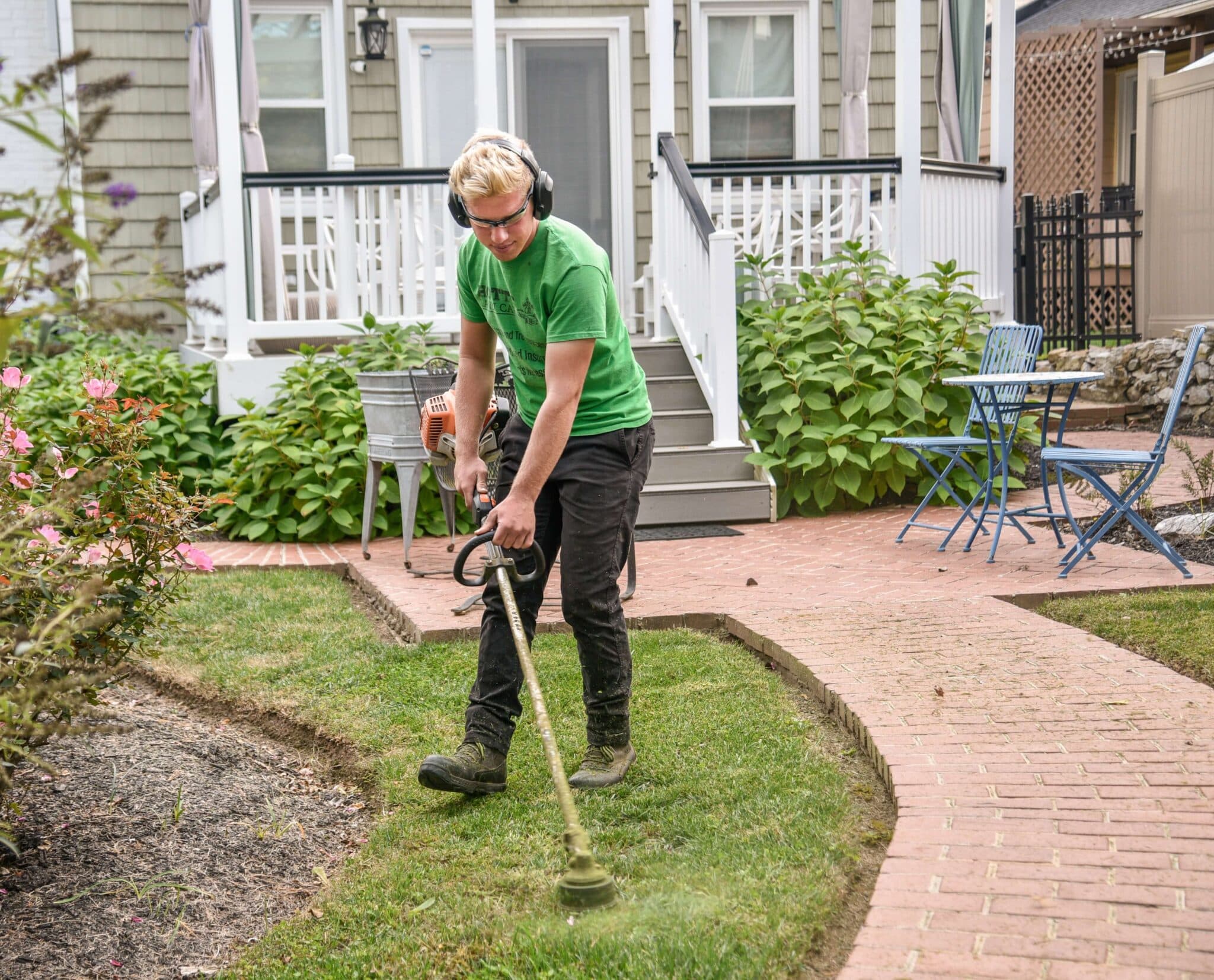Weed Whacking Tips: How to Get the Job Done Right
Weed whacking can be a daunting task. If you’re not familiar with the right techniques, you could easily spend hours trying to get the job done, and still end up with a yard full of weeds.
In this guide, we will discuss some weed whacking tips that will help you get the job done quickly and efficiently. We’ll also cover some of the most common mistakes people make when weed-whacking, so you can avoid them.

What is Weed Whacking?
Weed whacking, also known as weed-eating or line trimming, is the process of cutting weeds with a tool called a trimmer. Trimmers come in both gas and electric models, and they usually have a long, flexible shaft with a cutting head at the end.
The cutting head is what does the work. It has a line or blade that spins very quickly, and that’s what cuts the weeds. You can use a trimmer to cut grass too, but it’s not as effective as a lawnmower.
Why Weed Whack?
Weed whacking is a necessary evil for many homeowners. If you have any type of landscaping, chances are you’ll need to weed whack at some point. Even if you don’t have landscaping, weeds can still take over your yard if you’re not careful.
Weed whacking is the best way to remove weeds that are growing in areas where it’s difficult to use a lawnmower, such as along fences, in garden beds, or around trees. It’s also the best way to remove weeds that are growing in cracks in sidewalks or driveways.
When to Weed Whack?
The best time to weed whack is early in the morning, or late in the evening when it’s cooler outside. Avoid weed whacking in the middle of the day, when it’s hot, and the sun is beating down on you.
You should also avoid weed whacking if the ground is wet, as this can make the job more difficult and increases your chances of slipping.
Step By Step Guide to Weed Whacking
Now that we’ve covered the basics, let’s get into the nitty-gritty of weed whacking. Follow these steps for best results:
What you need:
- Gas or an electric trimmer
- Safety glasses
- Ear protection
- Long pants and long sleeves (to protect your skin from the trimmer line)
Instructions:
Step 1 – Wear safety gear
Before you start weed whacking, it’s important to put on the proper safety protective gear. This includes safety glasses, ear protection, and long pants and sleeves. It’s also a good idea to tie back long hair.
Step 2 – Start the trimmer
If you’re using a gas trimmer, start it according to the manufacturer’s instructions. If you’re using an electric trimmer, plug it in and turn it on. If your trimmer has speed control, it’s best to start at the lowest setting.
Step 3 – Hold the trimmer correctly
Most trimmers have a U-shaped handle that you should hold with both hands. Place your right hand on the front handle, and your left hand on the rear handle. If your trimmer has a shoulder strap, put it on to help distribute speed control, and start at the lowest setting.
Step 4 – Trim around the edges first
When you start weed whacking, it’s a good idea to trim around the edges of your yard first. This will help you get a feel for the trimmer and how it works. Once you’re comfortable, you can move on to larger areas.
Step 5 – Work in small sections
Don’t try to trim too much at once, as this can lead to you getting tired quickly. Work in small sections, and take breaks often.
Step 6 – Be careful of obstacles
As you’re weed whacking, be careful of obstacles like rocks, tree roots, and gravel. These can damage your trimmer, or cause you to trip.
Step 7 – Empty the trimmer often
If you’re using a gas trimmer, empty the fuel tank when it’s half full to avoid spillage. If you’re using an electric trimmer, unplug it and wrap up the cord when you’re not using it.
Step 8 – Clean the trimmer
When you’re finished weed whacking, clean the trimmer and put it away. If you’re using a gas trimmer, empty the fuel tank and run the engine until it’s out of gas. This will help prevent corrosion. If you’re using an electric trimmer, unplug it and clean the cutting head.
Common Mistakes to Avoid
Now that you know how to weed whack like a pro, let’s go over some common mistakes to avoid:
- Not wearing safety gear – This is the most important tip. Always wear safety gear when using a trimmer.
- Not checking the trimmer line – The trimmer line is what does the actual cutting, so it’s important to make sure it’s in good condition. If it’s frayed or broken, replace it.
- Not checking for obstacles – Be careful of obstacles like rocks and tree roots when weed whacking. These can damage your trimmer, or cause you to trip.
How Dangerous Is Weed Whacking?
Weed whacking can be dangerous if you’re not careful. Every year, there are reports of people being injured by flying bits of debris or by the machines themselves. In order to avoid becoming a part of this statistic, it’s important to follow some basic safety rules.
The danger posed by weed whackers is often underestimated. These seemingly innocuous machines are responsible for a surprising number of accidents every year.
The danger level increases if the operator is not paying attention, or is not experienced. Always take caution when operating a weed whacker, and be sure to read the safety manual before use.
Should you Trim Before or After Mowing?
If you have a lawn, you’ve probably wondered whether you should trim the edges before or after mowing. The answer depends on a few factors, such as the type of grass you have and the length of your lawn.
If you have a short lawn, it’s best to trim first, and then mow. This will help prevent the weed trimmer from damaging the mower. If you have a long lawn, it’s best to mow first and then trim. This will help prevent you from tiring yourself out. Mowed grass also tends to lay down better, making it easier to trim.
How to Prevent Weeds from Growing
Weed whacking is a great way to keep your yard looking neat and tidy, but what if you want to prevent weeds from growing in the first place?
Here are a few tips:
- Use mulch – Mulch helps prevent weeds from growing by blocking out sunlight.
- Pull them up – The best way to prevent weeds from growing is to pull them up as soon as you see them.
- Use herbicides – Herbicides can be effective at preventing weeds from growing, but they should be used sparingly.
Weed whacking is a great way to keep your yard well-maintained, and by following these tips, you’ll be able to keep them that way for much longer.
How do you Hold a Weed Eater to the Edge?
The best way to hold a weed eater to the edge is to use both hands. One hand should be on the trigger, and the other hand should be on the shaft. For more control, you can also wrap your hand around the cutting head.
Weed eaters are also equipped with a shoulder strap that can be used to distribute the weight evenly, and to make it easier to control its speed.
Where Should I Find the Cutting Power Switch?
The cutting power switch is typically located on the handle of the weed whacker. It’s important to read the manual before use so that you can familiarize yourself with the location of all the controls.
This will help you operate the machine more safely. If you can’t find the cutting power switch, don’t hesitate to ask a salesperson for help.
Frequently Asked Questions
Does the string trimmer line go bad?
The string trimmer line can go bad if it’s exposed to sunlight, or if it’s stored in a damp environment. If the line is frayed or broken, replace it.
How much is the line for a weed whacker?
The line for a weed wacker varies in price depending on the type and quality. You can typically find a good quality line for around $20.
How does lawn stand edger work?
A lawn edger is a tool that is used to trim the edges of a lawn. It usually has a blade or wheels that rotate to cut the grass. Some lawn edgers also have a motor to make the job easier.
Can I use lawn mower blades on my weed whacker?
No, you should not use lawn mower blades on your weed whacker. The blades are of different sizes and shapes, and they can damage the weed whacker. It’s also dangerous because the blades can come flying off and injure you.
Can I get rid of tall grass using a weed whacker?
Yes, you can use a weed whacker to get rid of tall grass. Just be sure to use the proper cutting attachments, and follow all the safety precautions.
Conclusion
Weed whacking is a great way to keep your yard looking neat and tidy. However, it’s important to be safe when using a trimmer. Always wear safety gear, check the trimmer line, and be careful of obstacles. If you follow these tips, you’ll be able to weed whack like a pro.







